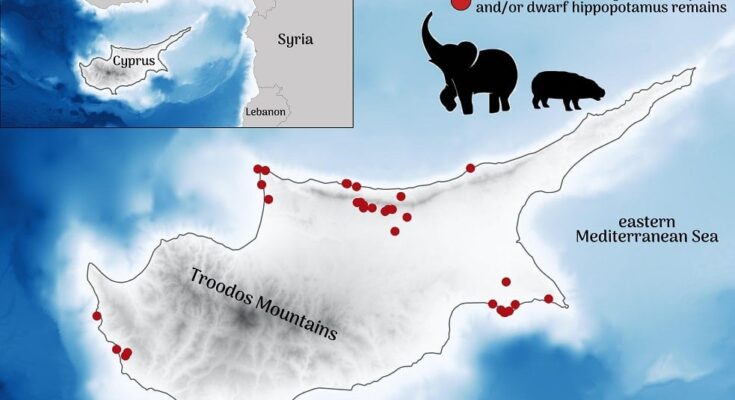
Scientists from Australia and Cyprus shed new light on the disappearance of dwarf elephants and dwarf hippos on Cyprus 14,000 years ago. Until recently, their extinction had remained an ancient European mystery.
The two species, fossil remains of which have been discovered in limestone caves, roamed the picturesque landscape of the Mediterranean island of Cyprus prior to the arrival of Paleolithic humans.
Complex mathematical models were employed to determine whether those prehistoric mammals were hunted down to extinction after the arrival of humans on the island. This was a hypothesis that was, until recently, met with disbelief by the scientific community.
Besides resolving this particular mystery on the particular species at that specific time and space, the findings of the research are also extremely important for a number of disciplines because they lay the foundation for a deeper understanding of the impact that small human populations might have in disrupting native ecosystems and causing major extinctions even in a period of low technological capability.

The surprising results, obtained through the work of Corey Bradshaw, Frédérik Saltré, Stefani Crabtree, Christian Reepmeyer and Theodora Moutsiou, were recently published in the Proceedings of the Royal Society.
Hunting practices explain mystery of extinction
The 500-kilogram (approx. 1,100 pounds) dwarf elephant, scientifically known as Palaeoloxodon cypriotes, and the 130-kilogram (approx. 286 pounds) dwarf hippo, known as Phanourios minor, were the only species of large mammals present on the island of Cyprus during the Late Pleistocene. This was the geological period that included the last Ice Age and saw the spread of modern humans outside of Africa as well as the extinction of all other human species.
Both the dwarf elephant and the dwarf hippo disappeared soon after humans arrived on Cyprus around 14,000 years ago, but initial research suggested that the introduction of a small human population on the island could not have caused these extinctions so quickly.

The new research, however, funded by the European Regional Development Fund and the Republic of Cyprus through the Research and Innovation Foundation for project MIGRATE, found that Paleolithic hunter-gatherers on Cyprus could have indeed first driven dwarf hippos and then dwarf elephants to extinction in less than one thousand years.
Scientists built mathematical models combining data from various disciplines, including paleontology and archeology, to show that Paleolithic hunter-gatherers on Cyprus are most likely the main cause of the extinction of these species due to their hunting practices.
According to previous findings by Professor Bradshaw, Dr Moutsiou, and collaborators, large groups of hundreds to thousands of people could have arrived on Cyprus in two to three main migration events in less than a thousand years.

Insular environment seals validity of data model
The four researchers that collaborated on the paper titled “Small populations of Paleolithic humans in Cyprus hunted endemic megafauna to extinction,” used data-driven approaches to reveal the impact of rapid human settlement on driving the extinction of species soon after their arrival.
Counting in detailed reconstructions of human energy demand, diet composition, prey selection, and hunting efficiency, the model demonstrates that 3,000 to 7,000 hunter-gatherers predicted to have existed on the island were likely responsible for driving both dwarf species to extinction.
The predictions resulting from the model built to resolve the mystery of the extinction did in fact match the chronological sequence of megafauna extinctions in paleontological records.
“Our results therefore provide strong evidence that Paleolithic peoples in Cyprus were at least partially responsible for the megafauna extinctions during the Late Pleistocene and early Holocene. The main determinant of extinction risk for both species was the proportion of edible meat they provided to the first people on the island,” says lead author, Professor Corey Bradshaw of Flinders University.

Alongside its primary purpose of unravelling this ancient European mystery by focusing particularly on the Cyprus extinction, the research has also succeeded in testing the validity of its breakthrough mathematical models.
“Cyprus is the perfect location to test our models because the island offers an ideal set of conditions to examine whether the arrival of populations of humans ultimately led to the extinction of its megafauna species. This is because Cyprus is an insular environment and can provide a window back in time through our data,” commented co-author Moutsiou of the University of Cyprus.
The research on the Cyprus elephant and hippo extinction mystery forms part of the project Modelling Demography and Adaptation in the Initial Peopling of the Eastern Mediterranean Islandscape, hosted at the Archaeological Research Unit of the University of Cyprus and coordinated by Moutsiou.
Remains of the dwarf elephants and hippos found on the island are on display for visitors at the Akamas Geology and Paleontology Information Centre in PanoArodes in western Cyprus.



